Newsroom staff cutbacks are hitting print journalism at both the national and local level. About half of respondents working at newspapers or magazines (48% nationally, 54% locally) say the size of their newsroom staff has decreased in the past three years. Relatively few in the print sector are seeing growth in the number of staff.
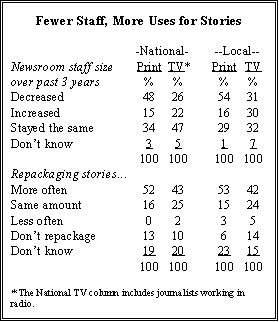 The picture is more mixed in television and radio, with about equal numbers saying their newsrooms are growing as shrinking. About half (47%) of those in national broadcast media say there has been no change in staffing compared with three years ago.
The picture is more mixed in television and radio, with about equal numbers saying their newsrooms are growing as shrinking. About half (47%) of those in national broadcast media say there has been no change in staffing compared with three years ago.
One significant change in the news business is growth in the practice of repackaging and repurposing news stories for multiple uses. About half of both national and local respondents (48% each) say they are doing this more now than in the past; print and broadcast journalists at each level are similar in this respect.
At the same time, relatively few voice unhappiness with this trend, with the notable exception of local broadcast reporters. Three-in-ten local TV reporters (29%) say they are unhappy over repackaging stories for multiple purposes. That compares with only about one-in-ten national radio and TV news people, and similar percentages of national and local print journalists.
Most journalists today give good ratings to the quality of leadership in their own organizations, a view that has changed little since 1999. At the national level, 30% of news professionals say their management is doing an excellent job, and 41% say they are doing a good job. There is relatively little difference between national print and broadcast media in leadership ratings. But over half of executives at the national level say the quality of leadership is excellent (and 38% rate it as good). Senior newsroom staff and line journalists are less positive.
 At the local level, 22% overall rate leadership as excellent, and nearly half (47%) say the quality is good. Ratings are higher among local newspaper journalists than among those in television and executives rate leadership more positively than reporters and producers.
At the local level, 22% overall rate leadership as excellent, and nearly half (47%) say the quality is good. Ratings are higher among local newspaper journalists than among those in television and executives rate leadership more positively than reporters and producers.
Training and professional development programs are fairly common in newsrooms today. About half (47%) of national journalists and 56% of local journalists say they have participated in such activities provided by their news organization in the past twelve months. Among those who have taken part in training, close to half say they participated in such a program for five days or more over the past year.
Executives and senior editors and producers are more likely than line staff to report having taken part in professional development activity. Respondents who have participated in training rate their own news organization’s management more highly than those who have not participated, and this is especially true of reporters.
In a related area, large majorities of respondents (76% nationally and 77% locally) say there are ongoing management efforts to address ethical issues in their newsroom, about the same as in 1999. As with training and professional development, those who report that their organizations are engaged in this activity rate their management more favorably.
Internet’s Impact Mostly Positive
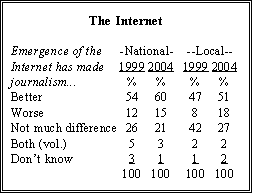 Most news professionals (60% at the national level, 51% locally) say the emergence of the Internet has made journalism better; very few say it has hurt journalism. These views are fairly similar to those expressed by journalists in 1999. More local journalists say the Internet has had either a positive or negative impact, with higher percentage today saying it has made journalism worse (18% compared with 8% in 1999). Only local news executives are divided over the Internet’s impact: 31% say it has been good for journalism; 27% view it negatively.
Most news professionals (60% at the national level, 51% locally) say the emergence of the Internet has made journalism better; very few say it has hurt journalism. These views are fairly similar to those expressed by journalists in 1999. More local journalists say the Internet has had either a positive or negative impact, with higher percentage today saying it has made journalism worse (18% compared with 8% in 1999). Only local news executives are divided over the Internet’s impact: 31% say it has been good for journalism; 27% view it negatively.
Not surprisingly, enthusiasm about the Internet is greatest among younger respondents in the survey. More than seven-in-ten (72%) of those under 35 years of age think the Internet has been good for the profession; just 13% view it negatively. Journalists age 35 and older also have a generally positive view of the Internet’s impact , though by a much smaller margin (54% better, 15% worse).
Changes for the Better
 Those who believe the Internet has helped journalism most frequently cite its power as a research tool. Nearly half of those who see a positive impact of the Internet mention some aspect of the Internet as a convenient place to find timely information, to get data at any hour of the day, and to do fact-checking on deadline. Those who work for local news organizations are especially likely to mention this benefit of the Internet (61% of local vs. 47% of national and 16% of Internet journalists).
Those who believe the Internet has helped journalism most frequently cite its power as a research tool. Nearly half of those who see a positive impact of the Internet mention some aspect of the Internet as a convenient place to find timely information, to get data at any hour of the day, and to do fact-checking on deadline. Those who work for local news organizations are especially likely to mention this benefit of the Internet (61% of local vs. 47% of national and 16% of Internet journalists).
Another widely noted positive impact of the Internet is its ability to deliver information to the public more quickly and to promote greater competition among news organizations. This view is much more prevalent among print journalists than among those working in TV and radio. A frequent comment within this theme is that print journalism now has the ability to compete with television and radio for breaking news. Also, the speed of the Internet in delivering information was the single most cited benefit among journalists who work primarily on their organization’s websites.
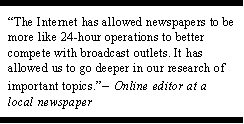 About one-in-five say the Internet has helped journalism by making far more information available to the public, and by helping to improve the accuracy of the information. A related notion, mentioned about as often, is that the Internet has broadened the range of outlets and voices available to the public. This includes more points of view, deeper stories, and coverage of topics and stories that otherwise would not have fit into existing time and space available. These changes have forced journalism to be more innovative and responsive to the public; one respondent said the Internet has “democratized the press.”
About one-in-five say the Internet has helped journalism by making far more information available to the public, and by helping to improve the accuracy of the information. A related notion, mentioned about as often, is that the Internet has broadened the range of outlets and voices available to the public. This includes more points of view, deeper stories, and coverage of topics and stories that otherwise would not have fit into existing time and space available. These changes have forced journalism to be more innovative and responsive to the public; one respondent said the Internet has “democratized the press.”
A less common argument for why the web has made journalism better is that the Internet has made journalism more accountable by enabling the public and other journalists to more easily verify the accuracy of information and communicate these concerns directly to those who produced a report. Only around one-in-twenty who see the web as having had a positive influence make this case.
Changes for the Worse
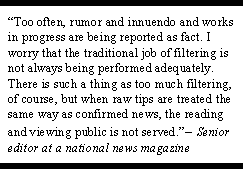 Those who think the Internet has been bad for journalism most often cite the fact that it promotes the spread of unvetted and unfiltered information to the public; nearly half (53% national, 45% local) cite this concern. Others express a related concern about the speed and pressure of the Internet leading to too many factual errors in news coverage (17% national, 29% local).
Those who think the Internet has been bad for journalism most often cite the fact that it promotes the spread of unvetted and unfiltered information to the public; nearly half (53% national, 45% local) cite this concern. Others express a related concern about the speed and pressure of the Internet leading to too many factual errors in news coverage (17% national, 29% local).
Another concern raised by some is that the Internet has promoted the rise of pseudo-journalism, “junk” sites, and low-brow news. One negative consequence cited by several respondents is that “news” reported on these sites force mainstream journalists to waste time chasing down baseless rumors and innuendo. In a similar vein, a smaller group refers specifically to the Internet having damaged the credibility of journalism in the mind of the public.
Around one-in-ten who see the Internet as having a bad influence on journalism say the web has made journalists lazy by allowing them to do research at their desks rather than going out into the field, with some specifically stating that the Internet has made plagiarism too easy.
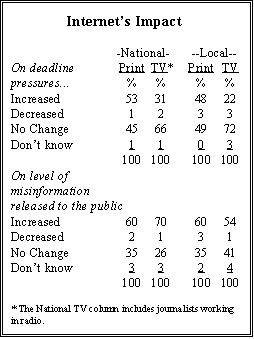
Internet’s Downside
The survey’s respondents were asked specifically about two issues related to the growth of the Internet: increased deadline pressures, and the potential spread of misinformation and rumors into the news. Majorities of both print and broadcast journalists say that the Internet has increased the amount of bad information that finds its way into news stories. Overall, 65% of national journalists and 57% of local journalists agree; smaller numbers think there has been no change (31% nationally, 38% locally). Hardly anyone thinks the Internet has reduced the amount of misinformation in circulation, though only 38% of those working with websites think the problem is worse because of the Internet.
But there is a considerable difference of opinion on the Internet’s impact on deadline pressures. Majorities overall believe the Internet has neither increased nor decreased such pressures (55% of national respondents, 60% of local respondents feel this way). Hardly anyone thinks deadline pressures have declined, and 42% at the national level and 35% at the local level say the pressure is greater.
Within these averages there is a great deal of variation by type of medium and by job title. At both the national and local level, print journalists are far more likely than TV and radio journalists to say deadline pressure has been increased by the Internet. National media executives are more likely than their editors or line journalists to feel this way. And, perhaps not surprisingly, those whose principal job responsibility is Internet-based journalism are the most likely to feel greater deadline pressures (78%).
Journalists in the Online Sector
The poll included a separate sample of 68 journalists whose job responsibilities include managing, editing, or writing for the online outlets of national and local news organizations. Job titles for this group of respondents included “online content manager,” “online editor,” “website manager,” and the like.
For the most part, online journalists are not significantly different from others demographically with the exception of age. The average age of respondents in the Internet group is 42, compared with 46 among the rest of the sample. Similarly, those working in online jobs had an average of 18 years experience, compared with 22 years for the rest of the respondents. More say they have undergone training or professional development activities provided by their organization (66% vs. 52%). And far more say the Internet has increased their deadline pressures.
Given the evolving nature of news organizations’ websites, it is no surprise that those in the online sector say they are doing more repackaging of stories than in the past: 71%, versus 48% for other journalists. But more are happy about the change than unhappy by a margin of five-to-one (44% vs. 9%).
 In most cases, the opinions of online journalists track closely with non-Internet journalists regarding the state of the profession, the reasons for declining audiences, the validity of criticisms about journalism, the quality of their own news organization, and their own personal and political values. They are somewhat more likely than their counterparts who work in broadcasting to say journalists have become out of touch with their audiences, and to offer that a boring and static news product is one reason some media are facing declining audiences, but many print journalists share this concern. In that vein, more online journalists than others in both print and broadcasting see the changing media environment as the biggest problem facing journalism.
In most cases, the opinions of online journalists track closely with non-Internet journalists regarding the state of the profession, the reasons for declining audiences, the validity of criticisms about journalism, the quality of their own news organization, and their own personal and political values. They are somewhat more likely than their counterparts who work in broadcasting to say journalists have become out of touch with their audiences, and to offer that a boring and static news product is one reason some media are facing declining audiences, but many print journalists share this concern. In that vein, more online journalists than others in both print and broadcasting see the changing media environment as the biggest problem facing journalism.
Not surprisingly, most of the key differences between the views of online journalists and others pertain to the role of the Internet itself. One of the biggest differences is that majorities (57%) of those whose principal job is not in online journalism say the Internet allows too much posting of links to material that is unfiltered or unvetted; just 28% of those working in the sector agree that this is a valid criticism. Similarly, far more of those who do not primarily work on their news organization’s website say the Internet has allowed more misinformation to find its way into news stories (61%, compared with just 38% among online journalists). And fewer Internet than non-Internet journalists say the Internet has hurt journalism (3% versus 16%).


